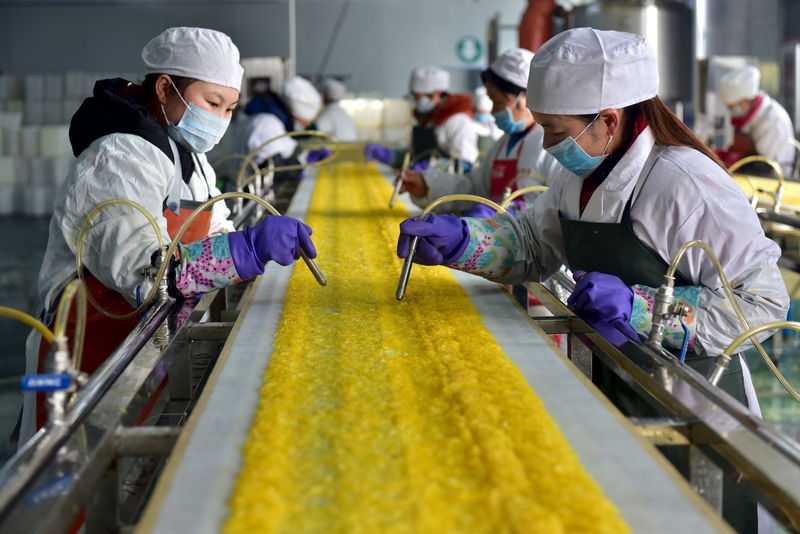By Kevin Yao and Huizhong Wu
BEIJING (Reuters) - China's factory production plunged at the sharpest pace in three decades in the first two months of the year as the fast-spreading coronavirus and strict containment severely disrupted the world's second-largest economy.
Urban investment and retail sales also fell sharply and for the first time on record, fanning views China's economy probably stalled or even shrank in the first quarter and that authorities would need to do more to resuscitate activity.
"Judging by the data, the shock to China's economic activity from the coronavirus epidemic is greater than the global financial crisis," said Zhang Yi, chief economist at Zhonghai Shengrong Capital Management.
"These data suggest a small contraction in the first-quarter economy is a high probability event. Government policies would need to be focused on preventing large-scale bankruptcies and unemployment."
Industrial output fell by a much larger-than-expected 13.5% in January-February from the same period a year earlier, data from the National Bureau of Statistics (NBS) showed on Monday.
That was the weakest reading since January 1990 when Reuters records started, and a sharp reversal of the 6.9% growth in December. The median forecast of analysts polled by Reuters was for a rise of 1.5%, though estimates varied widely.
The dire numbers also showed shocking weakness in the property sector and have prompted some analysts to further cut their forecasts on first-quarter economic performance, which were already pointing to a dramatic slowdown.
They may also mean Beijing needs to rethink its economic growth target for 2020.
China has yet to publicly issue its target, which would ordinarily be announced at the start of the annual parliament meeting. That meeting was originally scheduled for March 5 but was postponed due to the outbreak. Sources have said policymakers are debating whether to lower the planned annual growth target of around 6%, which was tentatively agreed late last year.
The Global Times on Monday quoted Wei Jianguo, vice head of the China Centre for International Economic Exchanges, a think-tank, as saying that China's 6% growth goal for 2020 remained intact.
However, many private-sector economists see that as already well beyond China's reach.
"Don't even think about it," said Hao Hong, head of research at BOCOM International.
"Even though China goes all in with stimulating policies in the property sector and infrastructure, that's still mission impossible."
QUESTIONABLE PROGNOSIS
The NBS in a statement on Monday said the impact from the coronavirus epidemic is controllable and short-term and that authorities would strengthen pro-growth policies.
Mainland China has seen an overall drop in new coronavirus infections, but major cities such as Beijing and Shanghai continued to wrestle with cases involving infected travelers arriving from abroad, which could undermine China's virus fighting efforts.
However, analysts warn it could take months before the economy returns to normal.
"While domestic conditions should improve slowly in the coming months, the mounting global disruption from the coronavirus will hold back the pace of recovery," said Julian Evans-Pritchard, Senior China Economist at Capital Economics.
Prior to a significant deterioration in the virus, analysts had predicted a rapid V-shaped recovery for China's economy, similar to that seen after the SARS epidemic in 2003-2004.
But the outbreak escalated just as many businesses were closing for the long Lunar New Year holidays in late January, and widespread restrictions on transportation and personal travel, as well as mass quarantine, delayed their reopening for weeks.
Factories may not be back to full output until April, some analysts estimate, and consumer confidence may take even longer to recover.
MORE SUPPORT NEEDED
The declines in industrial production, urban investment and retail sales indicators contrasted with gains in December and expectations in a Reuters poll for very modest growth.
Investment slumped 24.5% in January-February year-on-year while private sector investment dived 26.4%.
Retail sales shrank 20.5% as consumers shunned crowded places like shopping malls, restaurants and movie theaters.
China's jobless rate rose to 6.2% in February, up from 5.2% in December and hitting the highest since official records were published.
Pain was also seen in China's real estate market with property investment falling at its fastest pace on record while home prices stalled for the first time in nearly five years. Analysts expect March figures to be even worse.
Despite those numbers, NBS spokesman Mao Shengyong said short-term policies to support the property market were not among the government's broad suite of stimulus options.
Authorities have been ramping up economic support since the outbreak escalated, with most aimed at helping cash-starved companies stay afloat until conditions improve.
Other major global economies have more recently unleashed a wave of stimulus to prop up growth and ensure financial stability.
China's central bank said on Friday it would cut the amount of cash banks must hold as reserves (RRR), releasing another 550 billion yuan ($78.82 billion) to push down borrowing costs.
Mao from the NBS told reporters there was room for to raise budget deficit ratio this year, following recent fiscal stimulus including tax waivers, subsidies and cuts in social insurance fees.
China's central bank cut the amount of cash that banks must hold as reserves on Friday for the second time this year. The central bank has cut several key interest rates since late January, and some analysts are expecting another reduction in its benchmark lending rate this week.
"I'm worried about the small firms. The pressure of rent remains a problem and tax waivers don't mean much, as there's no revenues," said Hua Changchun, chief economist at Guotai Junan Securities.
"If Q1 GDP growth turns negative, there would be huge pressure to achieve the full year target, unless we can have a 8%-10% of GDP growth in the second quarter."
